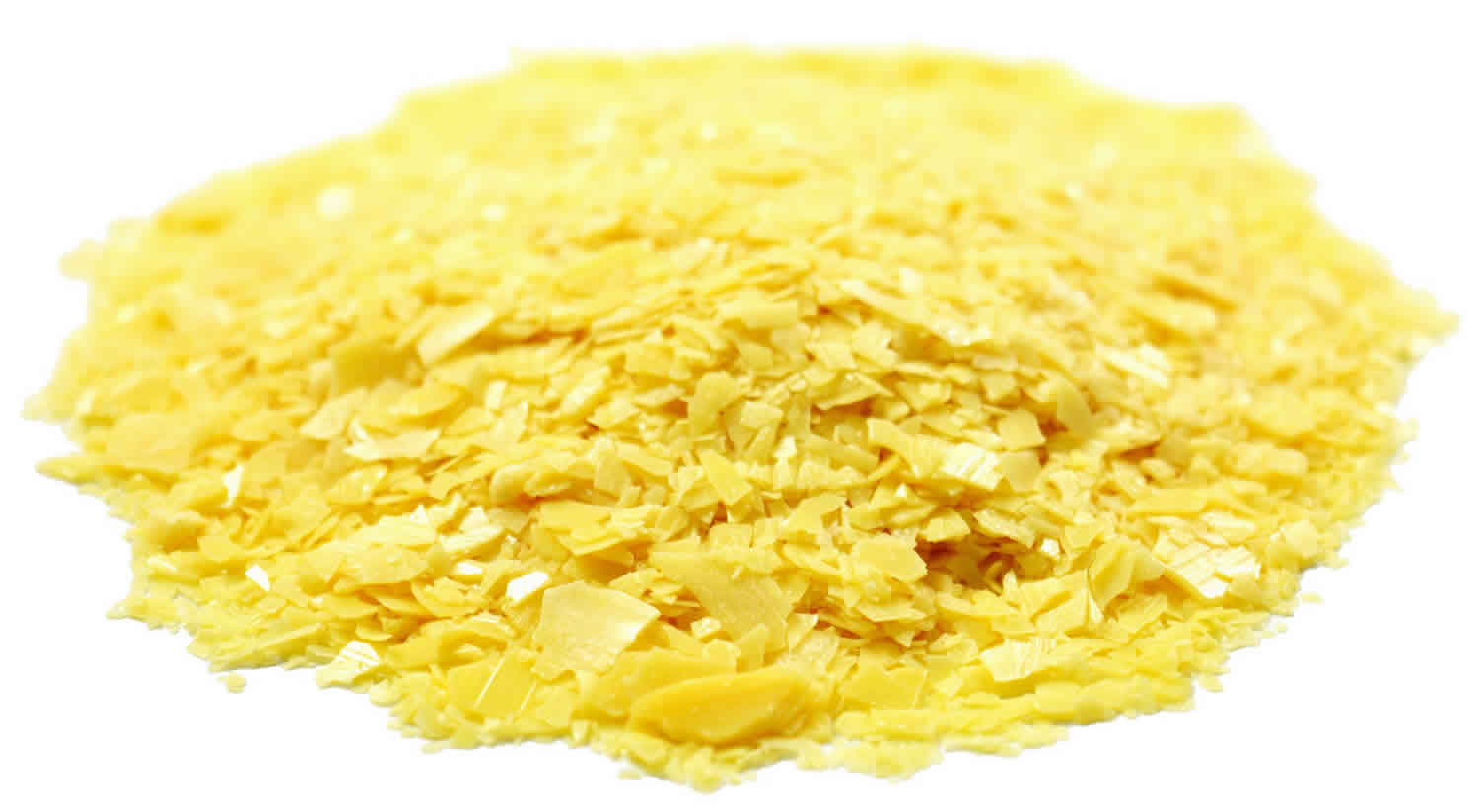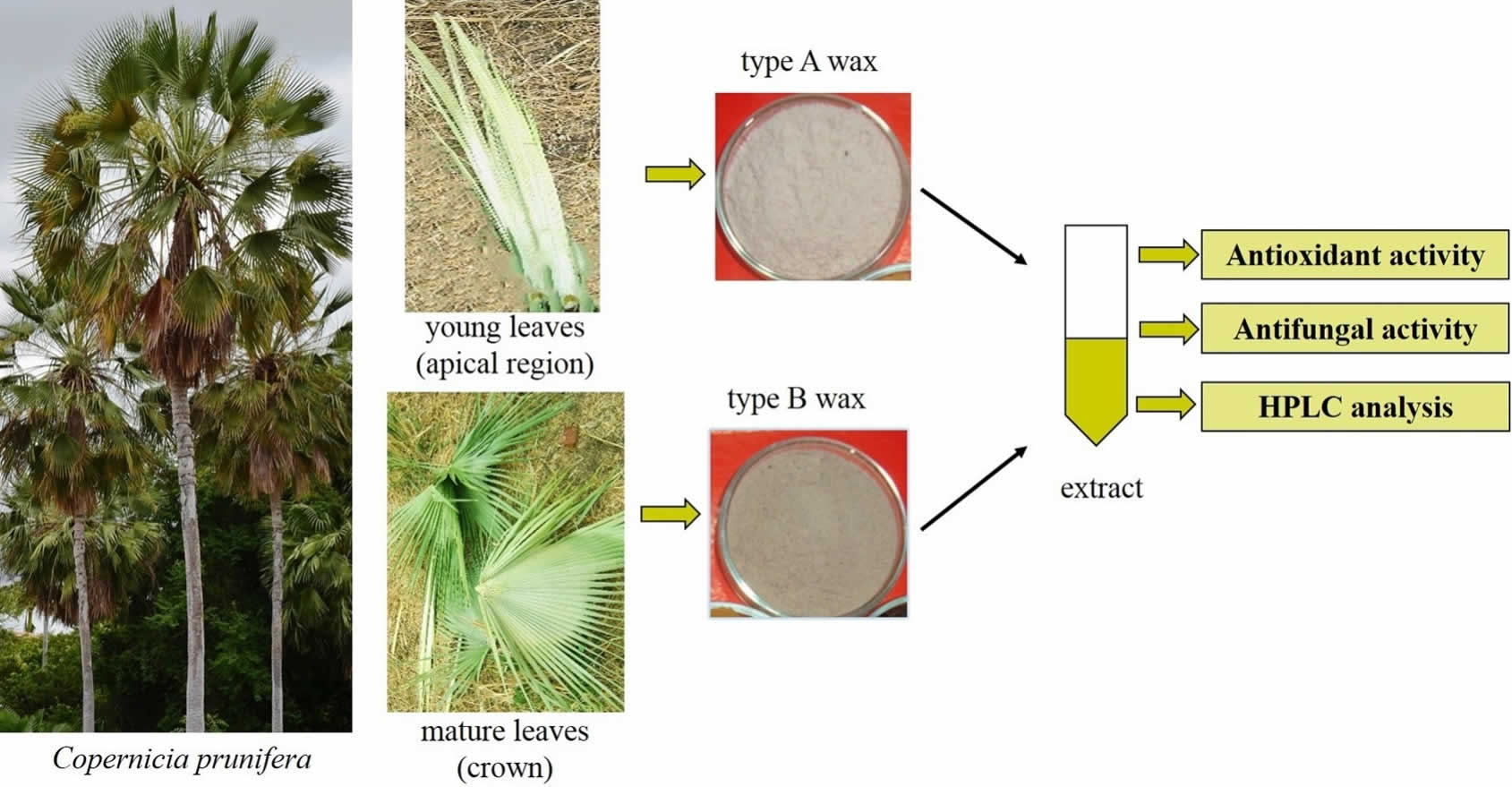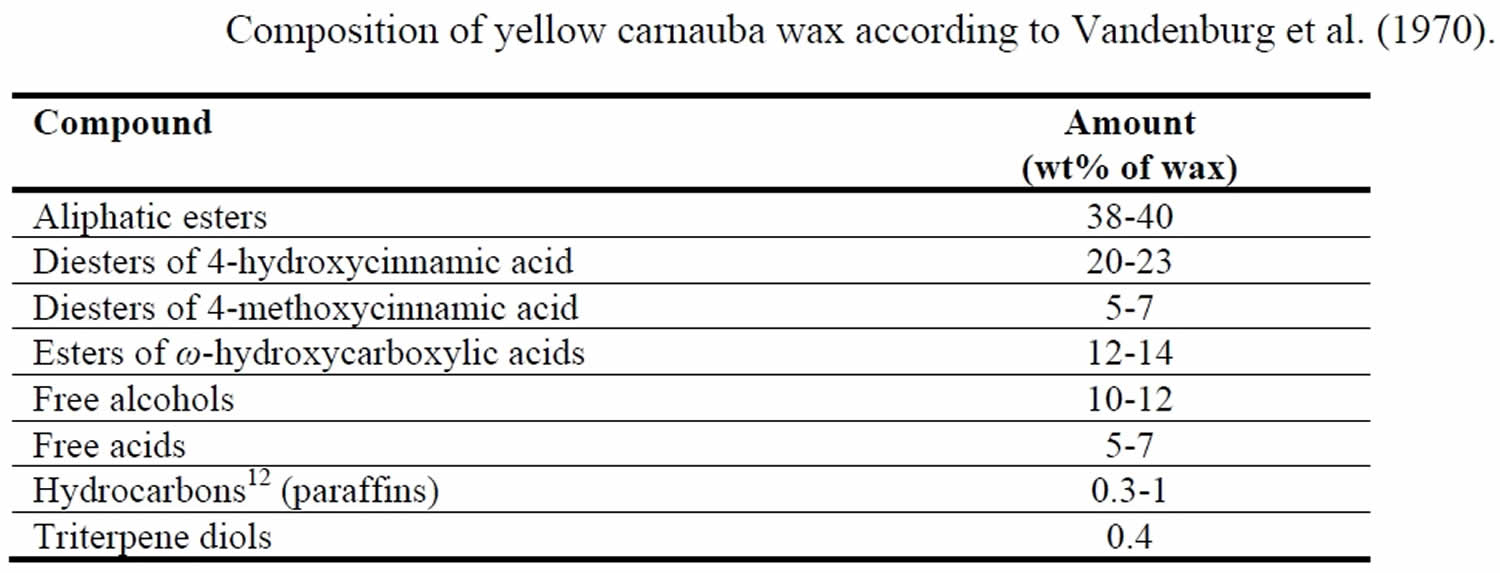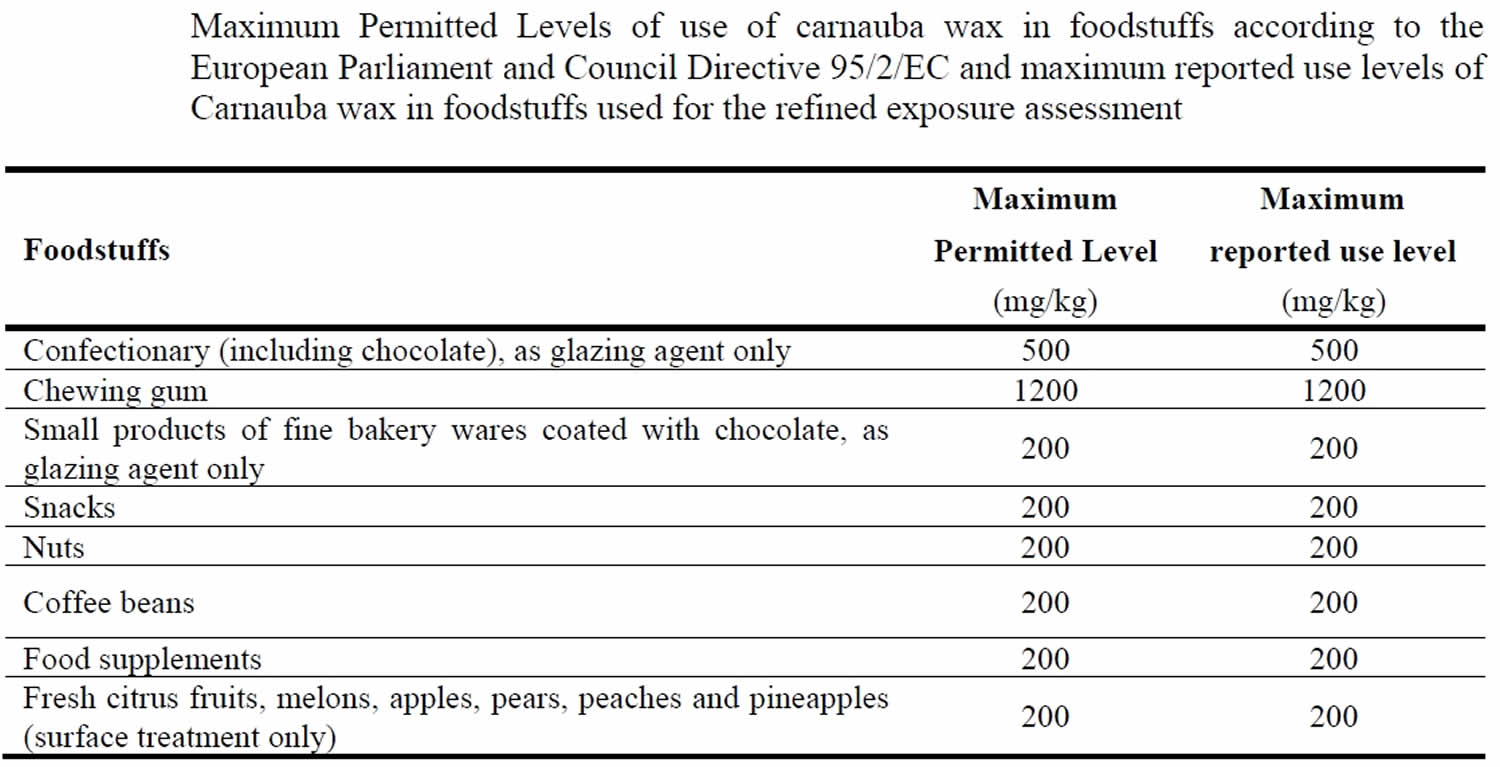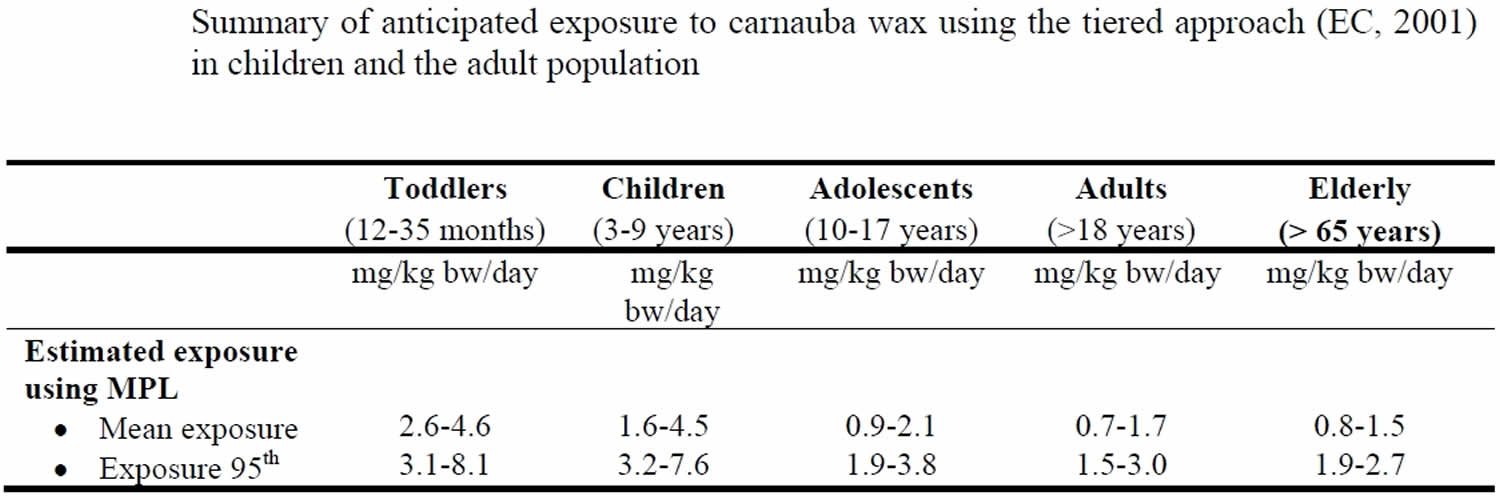What is carnauba wax
Carnauba wax also called Brazilian wax and palm wax, is a wax obtained from the leaf buds and leaves of the Brazilian Mart wax palm, Copernicia prunifera (Arecaceae), a plant native to and grown only in the northeastern Brazil 1. Carnauba wax is obtained from the leaves of the carnauba palm by collecting and drying them, beating them to loosen the wax, then refining and bleaching the wax. Carnauba wax is a complex mixture of compounds consisting mainly of aliphatic esters (wax esters), α-hydroxyl esters and cinnamic aliphatic diesters 2.
Carnauba wax also contains free acids, free alcohols, hydrocarbons and resins 2. Aliphatic esters are described by Joint FAO/WHO Expert Committee on Food Additives (JECFA) as consisting of straight-chain acids with even-numbered carbon chains from C24 to C28 and straight-chain alcohols with even numbered carbon chains from C30 to C34. Αlpha-hydroxyl esters are described as consisting of straightchain hydroxyl acids with even-numbered carbon chains from C22 to C28, straight-chain acids with even-numbered carbon chains form C24 to C28, straight-chain monohydric alcohols with even numbered carbon chains from C24 to C34 and dihydric alcohols with even-numbered carbon chains from C24 to C34. Cinnamic aliphatic esters are described as consisting of p-methoxycinnamic acid and dihydric alcohols with even-numbered carbon chains from C24 to C34 2. The European Food Safety Authority Panel noted that hydrocarbons would only constitute between 0.3 and 1% of the total composition of carnauba wax 3.
Carnauba wax is one of the hardest and highest-melting point natural waxes. At room temperature carnauba wax has a weakly aromatic odor and a characteristic hay-like scent in the molten state 4. Carnauba wax is identified as being insoluble in water, sparingly soluble in alcohol, but very soluble in chloroform and ether 5.
Carnauba wax has been evaluated by the Scientific Committee on Food 6 and by the Joint FAO/WHO Expert Committee on Food Additives (JECFA) who allocated an Acceptable Daily Intake (ADI) of 7 mg/kg body weight per day 7. The Scientific Committee on Food did not establish an acceptable daily intake (ADI) but considered the use of carnauba wax as a glazing agent acceptable 6. Scientific Committee on Food concluded that the use of carnauba wax was up to 1200 mg/kg of food would yield a worst-case intake estimate of 48 mg/person/day (equivalent to 4.8 mg/kg body weight per day for 10 kg child, or less for an adult) and these levels were within the acceptable daily intake (ADI) of 0 – 7 mg/kg body weight per day set by Joint FAO/WHO Expert Committee on Food Additives (JECFA) 6.
In the USA carnauba wax is classified as Generally Recognized as Safe (GRAS) by U.S. Food and Drug Administration (FDA) and is permitted with no other limitation than good manufacturing practice (GMP) in a variety of food products (FDA’s GRAS – 184.1978) 8.
Figure 1. Carnauba wax
Table 1. Carnauba wax composition
[Source 9 ]Carnauba wax manufacturing process
Carnauba wax is obtained from the leaves of the palm Copernicia cerifera. The wax is located on the outer palm leaves. After drying the leaves in the sun or on steam-heated racks, the wax is removed (loosened) from the leaves manually or mechanically. The dried leaves are chopped and the loosened wax chips are separated by an air classification process to give a mixture of approximately 60% wax and 40% chopped leaves. The primary purification process of the mixture involves melting in water with oxalic acid which gives a crude wax paste. The latter is heated to its boiling point and pressed through a filter while hot. Centrifugation of the filtrate gives virtually anhydrous wax. The remaining wax can be extracted from the dried filter cake with solvents (e.g. heptane). The crude product is normally supplied in lumps. Additional bleaching with hydrogen peroxide can also be carried out 4.
Carnauba wax in food
Carnauba wax in food is used as coatings for preserving quality and extending shelf-life of fresh fruits and vegetables 10. Carnauba wax is authorized in the European Union as food additive E 903 as glazing agent only to food supplements, small products of fine bakery wares coated with chocolate, snacks, nuts and coffee beans 11. Maximum permitted use is 200 mg/kg food 12. Carnauba wax is also permitted as surface treatment on fresh citrus fruits, melons, apples and pears as well as on peaches and pineapples up to 200 mg/kg food. In confectionary carnauba wax may be used up to 500 mg/kg and on chewing gum up to 1200 mg/kg 12.
Table 2. Maximum Permitted Levels of use of carnauba wax in food
[Source 3 ]Table 3. Summary of estimated exposure to carnauba wax from its use as a food additive of all five population groups
Footnote: The main contributors to the total anticipated mean exposure to carnauba wax for toddlers, children, adolescents and adults were fruits and confectionary. For toddlers fruits and confectionary contributed to 64-96% and 12-18% exposure, respectively, for children these contributions were 47-79% and 12-18%, for adolescents 44-81% and 11-19%, and for adults 60-93% and 11%, respectively. For the elderly, the main contributors to the total anticipated mean exposure to carnauba wax were fruits (79-95%).
MPL = maximum permitted level
[Source 3 ]The Scientific Committee on Food evaluated carnauba wax several times. In 1990 the Scientific Committee on Food reviewed acute oral toxicity studies and dermal teratogenicity studies on carnauba wax not showing any treatment-related adverse effects 13. The Scientific Committee on Food was unable to establish an ADI for carnauba wax but considered its use as
glazing agent at the levels examined as temporarily acceptable until toxicological data and technical data on use levels have been provided 13. In 1994 Scientific Committee on Food evaluated a 90-day rat toxicity study, a 28-week dog toxicity study, a combined reproductive and subchronic rat toxicity study, a rat teratogenicity study and in vitro mutagenicity studies in bacteria and yeast 14. The Scientific Committee on Food was informed at that time that use of carnauba wax on confectionery was unlikely to exceed 200 mg/kg food, thus resulting in intakes unlikely to exceed 1-2 mg/kg body weight per day. The Scientific Committee on Food extended the temporary acceptance of carnauba wax as a glazing agent pending submission of in vitro chromosome aberrations tests in mammalian cells 14. Information was also requested on the readiness of carnauba wax ester components to hydrolyze.
In 2001 the Scientific Committee for Food reviewed new genotoxicity assay and supplementary information on usage levels of carnauba wax as a glazing agent submitted following its request in 1997 15. The Scientific Committee for Food decided to withdraw the temporary acceptance status of carnauba wax and accepted its use as a glazing agent up to a maximum use level of 200 mg/kg of food 15. In an addendum to the latter opinion, Scientific Committee for Food considered a new request for use levels of carnauba wax of 500 mg/kg in confectionery (hard and soft sugar coated centers) and 1200 mg/kg in chewing gum as a glazing agent 16. The Scientific Committee for Food did not object the use of carnauba wax as a glazing agent at higher levels in products requiring it. The Scientific Committee for Food noted that a use level of 1200 mg/kg of food would yield a worst-case intake estimate of 48 mg/person/day which equates to 4.8 mg/kg body weight day for a 10 kg child, or less for an adult, and is within the ADI of 0-7 mg/kg body weight set by the Joint FAO/WHO Expert Committee on Food Additives (JECFA) in 1993 16.
The Joint FAO/WHO Expert Committee on Food Additives (JECFA) evaluated carnauba wax and based on short-term feeding studies in rats, a combined reproductive and developmental toxicity study in rats and in vitro mutagenicity studies, allocated an acceptable daily intake (ADI) of 0-7 mg/kg body weight per day based on the highest dose tested in the combined study in rats 7.
The European Food Safety Authority Panel considered that carnauba wax would be predicted to not be significantly absorbed from the diet and that if hydrolysed its main constituents could be absorbed and incorporated into normal cellular metabolic pathways. Based on the available data and the lack of structural alerts on carnauba wax it was concluded that there is no concern for genotoxicity for carnauba wax 3. Subchronic and reproductive and
developmental toxicity studies did not showed adverse effects related to carnauba wax intake 3. No chronic toxicity or carcinogenicity studies were available on carnauba wax. Overall, the European Food Safety Authority Panel considered that long-term toxicity data on carnauba wax were lacking and therefore did not establish an acceptable daily intake (ADI) 3. However, the European Food Safety Authority Panel considered that the exposure estimates to carnauba wax from the proposed uses resulted in sufficient margins of safety compared to the identified No Observed Adverse Effect Levels (NOAELs) for carnauba wax, allowing the European Food Safety Authority Panel to conclude that the use of carnauba wax as a food additive with the currently authorized uses would not be of safety concern 3.
Reaction and fate in foods, stability
No specific documentation has been submitted or found in the open literature, but as the components of carnauba wax are rather inert and stable it can be assumed that degradation or reaction with food components will not take place at significant extent 3.
Carnauba wax toxicity studies
Acute oral toxicity
Two unpublished acute oral toxicity studies in rats have been briefly reported. Administration by gavage to 10 Sprague-Dawley rats of a 20 000 mg/kg dose of a lipstick formulation containing 5.6% carnauba wax (representing a dose of 1100 mg/kg of carnauba wax) did not show deaths or toxic effects (no further details). In a second study, oral intubation of five rats (strain unknown) with a blush formulation containing 10% carnauba wax diluted to 33.3% in corn oil, making the wax concentration of 3.33%. None of the animals died when a 500 mg carnauba wax/kg body weight was administered.
Short-term and subchronic toxicity
Groups of 15 male and 15 female Wistar rats, approximately 5 weeks of age at the beginning of the study, were fed diets containing 0, 1, 5 or 10% carnauba wax, or 10% cellulose powder for 13 weeks corresponding to 0, 800, 4200 and 8800 mg/kg body weight per day for males and 0, 900, 4600 and 10 200 mg/kg body weight per day for females 17. The rats fed diets containing cellulose powder acted as a control group for possible effects due to the replacement of a significant proportion of the diet by a non-nutrient test material. Additional groups of five rats of each sex were fed diets containing 0, 5, 10% carnauba wax or 10% cellulose powder for 2 and 6 weeks. Food consumption and body weights were recorded. Hematological, serum biochemistry, urinalysis, organ weights, and gross examinations were recorded at autopsy. Histopathological examinations were done on half of the tissue sections conserved from the control rats and tissues from those given 10% carnauba wax or 10% cellulose powder. Results showed a significant increase in mean food consumption in male and female rats given 10% carnauba wax or 10% cellulose powder, without statistically significant differences in body weights compared to controls. A higher erythrocyte count at week 2 in male rats fed 10% carnauba wax was noticed, but no other statistical significant differences were recorded on haematological findings in rats fed diet containing 10% carnauba wax at 2, 6 or 13 weeks. Glutamicoxalacetic transaminase, glutamine-pyruvic transaminase and lactic dehydrogenase activities in serum were similar in treated and control animals. Few significant random differences in urinalysis (specific gravity, volume) were recorded. Organ weights did not show changes related to carnauba wax doses. Histopathological examination reported some inflammatory cell infiltration and few areas of focal necrosis in the liver, as well as some interstitial pneumonitis with similar incidences in 10% carnauba wax and 10% cellulose powder treated animals 17. A No Observed Adverse Effect Level (NOAEL) of 8800 mg/kg body weight per day can be derived by the European Food Safety Authority Panel from this study, the highest dose tested in male rats.
In a modified 90-day toxicity feeding study carried out to investigate “bioaccumulation” of carnauba wax, groups of 20 male and 20 female Fischer F-344 rats were fed diets containing carnauba wax corresponding to daily intakes of 0, 15, 150 and 1500 mg/kg body weight, respectively, continuously for 90 days (main study) 18. Additional two groups of 5 male and 5 female Fischer F-344 rats were assigned to a reversibility phase in which animals fed the control diet and a diet of 1500 mg/kg body weight per day of carnauba wax for 90 days were reverted to control diet for additional 90 days.
Observations throughout the study included general condition and behavior, body weight, food intake, ophthalmological observations, hematological examination, blood clinical chemistry and organs weight. Histological examination was conducted on selected organs after at least 90 days of treatment. Tissues from animals from the reversibility phase were not examined. A single female in the highest dosage group died spontaneously of brain haemorrhage on day 52 18.
The most frequent finding in the main study was that of red staining in the head region, which was observed in all groups, including controls. In the animals from the reversibility phase minor observations included red staining in the head region, areas of fur loss or unkempt fur and yellow staining in urinogenital areas, occurring in both treated and control groups. Given the similar patterns observed in both treated and control groups it was considered that no treatment-related adverse findings related to the condition and behavior were observed 18.
Among several endpoints, necropsied tissues such as heart, liver, kidney, spleen, lymph nodes and ileum, were microscopically evaluated. From these observations, the authors concluded that no evidence of lipid accumulation derived from carnauba wax was noted 18.
The body weights of the male animals were not statistically significantly different from the controls. For females, no marked differences from the controls were reported except for a significantly higher mean body weight of the females in the 15 mg/kg group at days 3 to 10. This difference disappeared by study day 14 and was thus considered as not treatment-related. No differences in mean body weights of male or female rats were reported after the reversibility phase of the study. During the study the feed intake of male and female rats fed carnauba wax was significantly higher in some animals at all doses tested compared to the controls. This finding was not considered to be an adverse effect and it might reflect feed compensation from increasing proportions of non-nutrient carnauba wax containing diets. No differences in feed intake were reported after the reversibility phase of the study. No abnormalities were reported upon ophthalmological examination. Occasional statistically significant differences in hematological findings and clinical chemistry parameters were observed in male or female rats. These changes were not dose related and were thus considered as not treatment related. No marked differences in these parameters were reported in animals after the reversibility phase of the study. Serum chemistry analysis showed slight occasional changes in clinical chemistry from animals in the 15 and 150 mg/kg body weight per day carnauba wax groups not observed in the 1500 mg/kg body weight per day group (lower chloride or protein concentration, higher albumin/globulin ration, higher alanine aminotransferase and lactate dehydrogenase activities). Few differences were reported in animals after the reversibility phase of the study 18.
The only differences found in organ weights in male rats were inconsistent increases in the mean absolute weight of the brain of the group fed 15 mg/kg body weight per day carnauba wax and a reduction in the mean relative weight of the thymus in the 15 and 1500 mg/kg body weight per day groups. No statistically
significant differences in any organ weight were reported in females. Upon histopathological examination the only finding reported was higher incidences of individual cell necrosis in the liver of male rats in the 15 and 150 mg/kg body weight groups; in the latter, a significant higher incidence of vacuolisation in the liver of male rats was also reported, but the 1500 mg/kg body weight per day animal group did not show these effects. No significant differences in histopathological findings were observed in the females. Overall, the histopathological examination of tissues taken at necropsy did not show any treatment related adverse findings 18. The European Food Safety Authority Panel identified a NOAEL of 1500 mg/kg body weight per day from this study, the highest dose tested.
Four groups of 6 male and 6 female Beagle dogs were fed diets containing 0, 0.1, 0.3 or 1% carnauba wax for 28 weeks (equivalent to 25, 75 or 250 mg/kg body weight per day) 19. Food consumption, body weights and behavioral effects were recorded weekly. Blood and urinary samples were collected at weeks 11 and 26. Organs were weighed (brain, pituitary gland, thyroid gland, heart, liver, spleen, kidneys, and adrenal glands), and gross and microscopic examinations of tissues were performed at the end of the study. No significant differences in body weights or food consumption were noted between treatment and control groups of animals. Data from serum biochemistry, urinalysis and organ weights did not show any treatment-related effects in dogs consuming carnauba wax. The only significant clinical observation at 26 weeks were the higher free fatty acid levels only in male dogs at all dietary levels of carnauba wax as compared to controls. Observations made after 11 weeks were comparable between groups. The authors noted that serum free fatty acid levels in this study were increased in male dogs at all doses of carnauba wax tested as compared to controls. However, the authors noticed that serum free fatty acid levels in treated male dogs remained within the normal historical range for Beagle dogs from the laboratory (200-800 μM/l), whereas the values in the controls in this study were comparatively lower (138 ± 38 μM/l) than the historical values. Ophthalmologic and gross examinations revealed no significant treatment-related effects for up to 1% carnauba wax in the diet. Histopathological findings were reported comparable between groups including controls 19. A NOAEL of 250 mg/kg body weight per day could be derived by the European Food Safety Authority Panel from this study, the highest dose tested.
No studies on chronic toxicity or carcinogenicity were available on carnauba wax 3, however in its 1994 opinion the Scientific Committee for Food already noted that the structure of the main components of carnauba wax (long-chain aliphatic esters) raises the possibility that it might behave like some mineral hydrocarbons 14. The European Food Safety Authority Panel considered that based on the available data and the lack of structural alerts on carnauba wax it can be concluded that there is no concern for genotoxicity for carnauba wax 3.
Overall, the European Food Safety Authority Panel considered that long-term toxicity data on carnauba wax were lacking and therefore did not establish an ADI. However, the European Food Safety Authority Panel noted that available toxicity studies consistently reported no findings associated with carnauba wax intake. Furthermore, consideration of the conservative exposure estimates to carnauba wax from the currently authorized uses indicated sufficient margins of safety, which allowed the European Food Safety Authority Panel to consider that the use of carnauba wax as a food additive with the currently authorized uses would not be of safety concern 3.
Carnauba wax uses
Carnauba wax is used as glazing agent, bulking agent, acidity regulator and carrier 2. Carnauba wax is used on pharmaceutical products (tablets) and in a range of technical applications like the formulation of stick and solid cosmetics (e.g. lip stick balms and lotion bars), in face and eye makeup preparations, fragrance preparations, hair coloring and conditioning preparations, manicuring and skin care products and suntan preparations.
Carnauba wax can produce a glossy finish and as such is used in automobile waxes, shoe polishes, dental floss, food products such as sweets, instrument polishes, and floor and furniture waxes and polishes, especially when mixed with beeswax and with turpentine.
Carnauba wax side effects
Overall, the European Food Safety Authority Panel considered that long-term toxicity data on carnauba wax were lacking and therefore did not establish an Acceptable Daily Intake (ADI). Furthermore, the European Food Safety Authority Panel noted that available toxicity studies consistently reported no findings associated with carnauba wax intake. Consideration of the conservative exposure estimates to carnauba wax from the currently authorized uses indicated sufficient margins of safety, which allowed the European Food Safety Authority Panel to consider that the use of carnauba wax as a food additive with the currently authorized uses would not be of safety concern 3. In the USA carnauba wax is classified as Generally Recognized as Safe (GRAS) by U.S. Food and Drug Administration (FDA) and is permitted with no other limitation than good manufacturing practice (GMP) in a variety of food products (FDA’s GRAS – 184.1978) 8.
Carnauba wax allergy
In the literature there have been three cases of carnauba wax allergy causing dermatitis:
- Allergic contact cheilitis caused by carnauba wax in a lip balm 20.
- Allergic contact dermatitis to propolis and carnauba wax from lip balm and chewable vitamins in a child 21.
- Allergic contact dermatitis from prime yellow carnauba wax and coathylene in mascara 22.
- Steinle, J. Vernon (September 1936). “Carnauba wax: an expedition to its source”. Industrial & Engineering Chemistry. 28 (9): 1004–1008. https://pubs.acs.org/doi/10.1021/ie50321a003
- JECFA, 1998. Carnauba wax. Specifications prepared at the 51st JECFA, published in FNP Add 6. http://www.fao.org/fileadmin/user_upload/jecfa_additives/docs/Monograph1/Additive-109.pdf
- Scientific Opinion on the re-evaluation of carnauba wax (E 903) as a food additive. EFSA Journal 2012;10(10):2880 https://efsa.onlinelibrary.wiley.com/doi/pdf/10.2903/j.efsa.2012.2880
- Krendlinger, E. , Wolfmeier, U. , Schmidt, H. , Heinrichs, F. , Michalczyk, G. , Payer, W. , Dietsche, W. , Boehlke, K. , Hohner, G. and Wildgruber, J. (2015). Waxes. In Ullmann’s Encyclopedia of Industrial Chemistry, (Ed.). doi:10.1002/14356007.a28_103.pub2
- Commission Regulation (EU) No 231/2012 of 9 March 2012 laying down specifications for food additives listed in Annexes II and III to Regulation (EC) No 1333/2008 of the European Parliament and of the Council. OJ L 83, 22.3.2012, p 1-295.
- SCF, 2002. Addendum to the opinion of the Scientific Committee on Food on carnauba wax of 11 July 2001. https://ec.europa.eu/info/departments/health-and-food-safety_en
- JECFA, 1993. Toxicological evaluation of certain food additives and naturally occurring toxicants. Prepared by the 39th meeting of the Joint FAO/WHO Expert Committee on Food Additives, Held in Rome 3-12 February 1992. WHO Food Additives Series: 30, no 70.
- Food Additive Status List. https://www.fda.gov/Food/IngredientsPackagingLabeling/FoodAdditivesIngredients/ucm091048.htm
- Vandenburg LE, Wilder EA, 1970. The structural constituents of carnauba wax. Journal of the American Oil Chemists’ Society 47, 514-518.
- Edible Coatings for Extending Shelf-Life of Fresh Produce During Postharvest Storage. Reference Module in Food Science 2018. https://doi.org/10.1016/B978-0-08-100596-5.22262-2
- Regulation (EC) No 1333/2008 of the European Parliament and of the Council of 16 December 2008 on food additives. OJ L 354, p 16-33.
- European Parliament and Council Directive 95/2/EC of 20 February 1995 on food additives other than colours and sweeteners. OJ L 61, 18.3.1995, p. 1-40
- SCF, 1992. Second series of food additives of various technological functions (opinion expressed on 19 October 1990). Reports of the Scientific Committee for Food (Twenty-sixth series). https://ec.europa.eu/info/departments/health-and-food-safety_en
- SCF, 1997. Carnauba wax (opinion expressed on 16 December 1994). Reports of the Scientific Committee for Food (Thirty-sixth series). https://ec.europa.eu/info/departments/health-and-food-safety_en
- SCF, 2001. Opinion of the Scientific Committee on Food on carnauba wax (expressed on 11 July 2001). https://ec.europa.eu/info/departments/health-and-food-safety_en
- SCF, 2002. Addendum to the opinion of the Scientific Committee on Food on carnauba wax of 11 July 2001 (expressed on 17 April 2002). https://ec.europa.eu/info/departments/health-and-food-safety_en
- Rowland IR, Butterworth KR, Gaunt IF, Grasso P, Gangolli SD. 1982. Short-term toxicity study of carnauba wax in rats. Food and Chemical Toxicology 20, 467-471.
- Edwards AJ, 1998. A modified 90-day feeding study to investigate the potential for bioaccumulation of carnauba wax in the Fisher 344 rat, Study report from BIBRA International testing laboratory. Project No. 3180/1. Unpublished report.
- Parent RA, Cox GE, Babish JG, Gallo MA, Hess FG, Becci PJ, 1983a. Subchronic feeding study of carnauba wax in beagle dogs. Food and Chemical Toxicology 21:85-87.
- Allergic contact cheilitis caused by carnauba wax in a lip balm. Contact Dermatitis. 2013 Nov;69(5):318-9. doi: 10.1111/cod.12108. https://onlinelibrary.wiley.com/doi/pdf/10.1111/cod.12108
- Allergic contact dermatitis to propolis and carnauba wax from lip balm and chewable vitamins in a child. Contact Dermatitis. 2008 Apr;58(4):242-3. doi: 10.1111/j.1600-0536.2007.1261.x. https://onlinelibrary.wiley.com/doi/pdf/10.1111/j.1600-0536.2007.1261.x
- Allergic contact dermatitis from prime yellow carnauba wax and coathylene in mascara. Contact Dermatitis. 2002 Apr;46(4):244. https://onlinelibrary.wiley.com/doi/abs/10.1034/j.1600-0536.2002.460414.x
